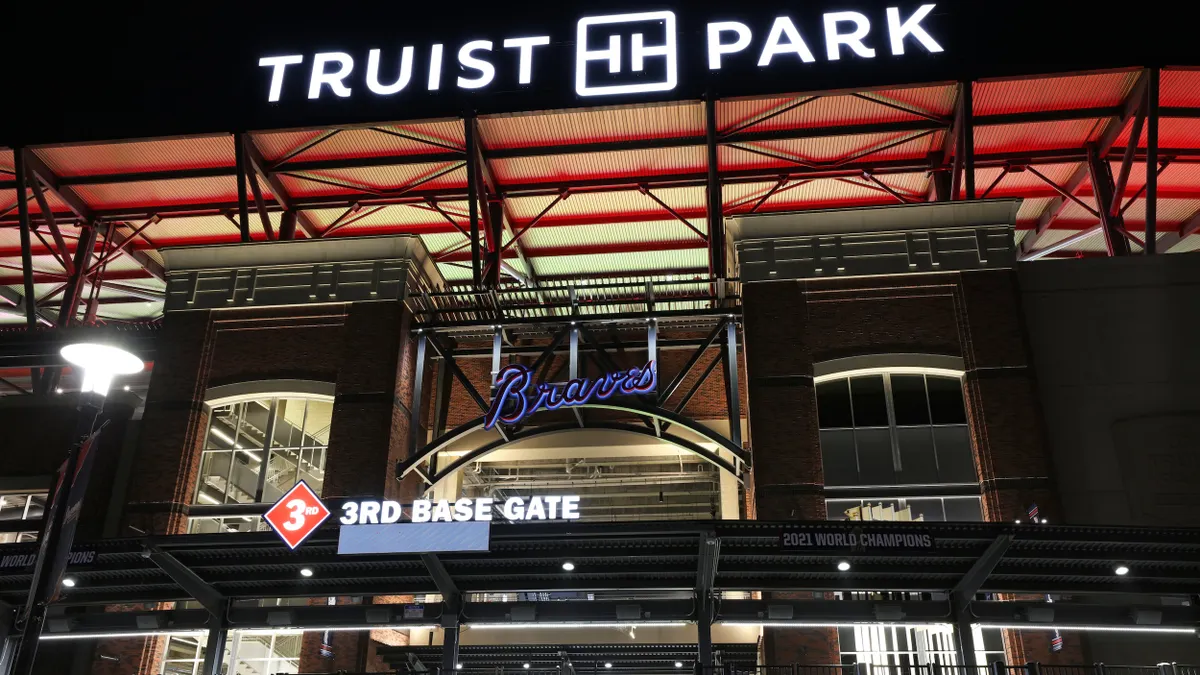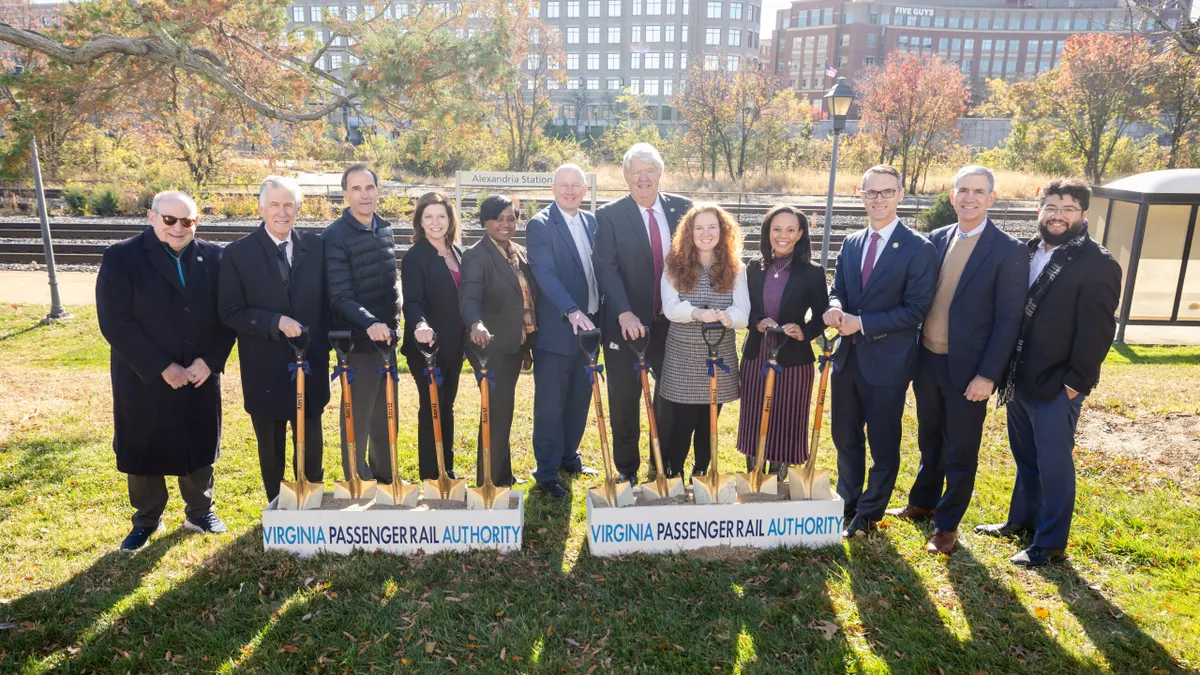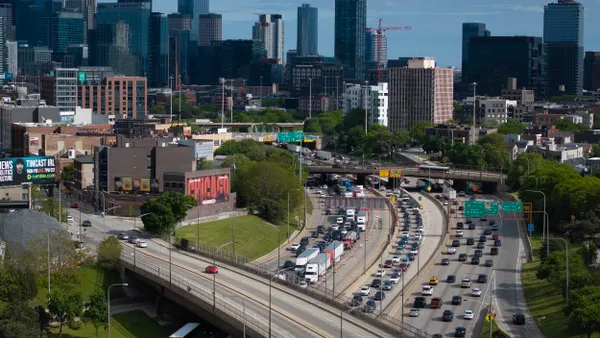By the end of the decade, the way people get around may be revolutionized by quick and affordable hyperloop trips — if predictions from supporters are correct.
While the potential of companies like Virgin Hyperloop One (VHO) shows promise for lighter traffic congestion and less reliance on crumbling roads, that's tempered by concerns over how hyperloop technology could impact existing transportation modes.
Experts say the needs of hyperloop must be balanced with current infrastructure, and there may be difficulties in working out a regulatory home for the technology and its financing. But supporters say, if done right, transportation is ripe for a change.
"My excitement about the hyperloop really stems from the fact that I view it as a new mode of transportation," Rick Geddes, professor and founding director of Cornell University's Program in Infrastructure Policy, told Smart Cities Dive. "And transportation, if you stop and think about it, has not really had a new mode since the Wright brothers in 1904."
The existing landscape
Boosters emphasize that hyperloop will naturally compete within the marketplace while offering something new. With speeds that could reach nearly 700 miles an hour, hyperloop promises to offer rapid connections to major population centers — which may cause traditional transportation offerings to fall by the wayside.
"You go when you want to go, you get there when you want to get there, and you don't stop at every place along the way," VHO Chief Technology Officer Josh Giegel said during a press conference last year on Capitol Hill.
Hyperloop could also bolster transit in areas of the country that rely heavily on cars. VHO's feasibility study of a route through Missouri found it could be commercially viable and safe, and could have tracks along Interstate 70, providing it a clear route and a contrast to existing infrastructure.
"We think incrementally as we go, we're going to continue to prove the viability of this technology so that over time the risk we're taking is less and less."

Mary Herman
General Counsel, Virgin Hyperloop One
"We can no longer afford to develop, implement and invest in policies and infrastructure that rely on yesterday’s transportation and mobility solutions," Tina Quigley, then-general manager of the Regional Transportation Commission of Southern Nevada, said during a 2018 hearing of the Senate Committee on Commerce, Science and Transportation on emerging transportation technologies.
Stan Caldwell, executive director of Carnegie Mellon University's Traffic21 Institute, said hyperloop could end up being an alternative to inter-city air travel, similar to the traditional rail system. That would be further helped by hyperloop stops closer to downtown than most airports, which are typically outside of downtown.
Hyperloop won't necessarily replace existing modes of transportation though, according to Thea Walsh, director of transportation and infrastructure development at the Mid-Ohio Regional Planning Commission. The intention is to be more holistic, she said during a panel discussion on the technology at the Transportation Research Board's (TRB) annual meeting in Washington, DC last month.
"We're not just planning for one new mode," Walsh said. "It's going to exist in a very multimodal world. It's part of a system... in my mind, it enhances an existing system. We don't see this as replacing every single mode on the map, but it's the strategic usage of it in places where it makes sense."
Discussions around hyperloop may still be in their very early stages for public transit officials. A spokesman for the National Association of City Transportation Officials (NACTO) declined to comment on the group's position, while a spokesman for the American Public Transportation Association (APTA) did not respond to requests for comment.
Extensive passenger service to compete with or complement public transit may be a long time coming, however. During the TRB panel discussion, VHO General Counsel Mary Herman said the company would likely look to prove the viability of hyperloop incrementally, which will be dependent on proving its safety. Speakers at TRB said it will be imperative to manage expectations and to be as transparent as possible when it comes to safety improvements and development.
"Tell me your speed records, that's great," said Bryant Walker Smith, an associate professor at the University of South Carolina’s School of Law. "But at the same time, be willing to tell stories about what's hard. What hasn't worked, what are you still struggling with, what hasn't gone as you expected? This is the kind of honesty and presentation that will build the credibility that I think we will need to sustain these discussions over the years or decades that they will last."
Finding a 'regulatory home'
While hyperloop's promise of ultra-fast connections may be appealing, it remains to be seen how it will be regulated in comparison to traditional modes of transportation. VHO officials have said publicly it would like to be regulated by the Federal Railroad Administration (FRA), as the agency's oversight already closely mirrors the needs of hyperloop.
"For us, it's really about where the regulatory home sits," Giegel told Smart Cities Dive in an interview last year. "That allows a couple of things to occur. It allows people to understand the jurisdictions that you might need to fall under from a regulatory point of view and understand the opportunities for finance, whether that be public-private partnerships (P3s) or government loans or whatever it might be."
Caldwell noted parallels with autonomous vehicles (AVs) and ride-hailing, which both have been the subject of intense debate among regulatory agencies after arriving suddenly.
"There were very specific lanes and programs for a lot of transportation modes, so when these new modes come in, like even when TNCs came in like Uber and Lyft, and micromobility like the scooters and the bike-share, and things like maglev or hyperloop, they don't fit into a normal box either from a regulatory side or a funding side," Caldwell said. "That's just by their definition why they're disruptive."
There are signs that the federal government is looking to get its arms around disruptive transportation technologies. U.S. Department of Transportation (USDOT) Secretary Elaine Chao announced last year the creation of the Non-Traditional and Emerging Transportation Technology (NETT) Council, which she said would help address modal silos at USDOT and ensure emerging transportation technologies receive proper review and support. An FRA spokesperson told Smart Cities Dive in an email that the NETT Council is still in the process of determining how to support regulatory development for hyperloop, but said no decisions have been made so far.
Observers said the development of NETT showed the federal government's willingness to experiment, and to alleviate concerns around introducing new risks into the transportation system.
"There's a lot of risk aversion," Geddes said. "Nobody really wants to sign off and say yes, this technology is safe for human travel, and then have some horrible accident occur. There's a lot of risk aversion in the regulatory process anyway, but if you're adding this element of it being a completely new technology that hasn't been tested, then it's going to be even slower."
But it could still be a long time before there is regulatory certainty, depending on how quickly things move. Geddes said the government should also play a future role in determining basic standards of hyperloop technology, like the diameter of the tubes, and how features like propulsion, braking and levitation would work.
Funding and business models
Perhaps the most visible way hyperloop will be compared with existing transportation modes will be in its ticket price, a topic Herman said she is asked about often. The Missouri feasibility study envisioned a ticket price that would cost less than driving, and although it did not go into specifics, Herman said it would need to be competitive and not just a playground for the rich.
"We really do envision this as a high throughput mass transit system," she said. "It has the potential to move tens of thousands of people per hour. If we're setting a price where it's not getting that utilization, it's not serving people the way it's supposed to."
That feasibility study also does not go into the costs associated with building hyperloop infrastructure, leaving a lot of doubt for city leaders and potential investors. Geddes said that while the first-ever route may be a big investment, economies of scale will bring those costs down over time.
"There's a lot of risk aversion ... Nobody really wants to sign off and say yes, this technology is safe for human travel, and then have some horrible accident occur."

Rick Geddes
Professor and founding director, Cornell University’s Program in Infrastructure Policy
"The first hyperloop route from point A to point B is probably going to be a pretty expensive ride, because you have these huge fixed costs to pay," he said, pointing to costs of the tube, the pylons, environmental permitting and other elements. "Unless it gets subsidies, the company that's providing that service has got to cover those costs. So the more scale you get, the more riders, you can spread those fixed costs over more and more riders and the costs will come down."
VHO and others have said they will seek private funding for hyperloop infrastructure, something that may quell concerns around the distribution of funds ordinarily used for roads, bridges and transit. Caldwell said placing the emphasis on private funding should help ensure there is a business case.
"That's one benefit to a privately-funded system: the investor market will determine the feasibility of a project, which I think avoids the shiny-object component from a public sector side where something might just be politically pushed through because it's a shiny object," he said.
While there appears to be a desire to use private financing to build and operate hyperloop, some VHO officials have also said they are open to public help, too. In written testimony before the Senate Commerce Committee’s 2018 hearing, VHO Vice President of Business Strategy Josh Raycroft said projects using VHO technology should be eligible to receive "relevant federal programs designed to support these projects," including Railroad Rehabilitation and Improvement Financing (RRIF).
Geddes said he would "not support" spending public monies on hyperloop infrastructure, but said the likes of the U.S. Department of Energy (DOE) and Department of Defense (DoD) could set aside research and development money for the technology.
"I would not want to see money that should be spent repairing potholes being diverted to hyperloop, with the caveat that the federal government does fund a lot of research and development on new technologies all the time," he said.




















